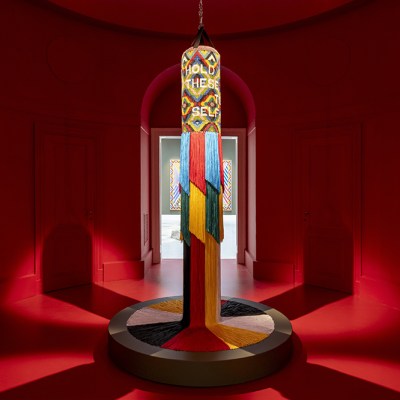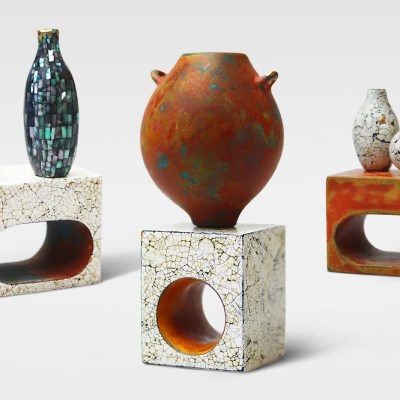From the July/August 2024 issue of Apollo. Preview and subscribe here.
‘Up, down. Over and under. It’s really basic.’ Jeremy Frey is talking about basketry. He’s devoted his life to this art form, going deep into its possibilities, all the while being keenly aware of its limitations. ‘To innovate, to do something different, it’s hard,’ he says. ‘So for me to get to where I’ve gotten is almost miraculous.’ He’s not wrong. Of course, binary coding has taken humanity a long way. But Frey is not handling zeroes and ones. He is building on the tradition of the Passamaquoddy, one of four federally recognised Wabanaki tribes in the present-day state of Maine. People have been making ash splint baskets here across a long and troubled history. As the foremost practitioner of the craft today, Frey is the inheritor of it all: the distinctive techniques, the cultural significance, the accumulated material intelligence.
This makes his current exhibition at the Portland Museum of Art (until 15 September, then travelling to the Art Institute of Chicago, 26 October–10 February 2025), simply titled ‘Woven’, much more than just a personal retrospective. Frey is the first artist of Wabanaki heritage to be so honoured; the show is a proud and defining moment not only for him, but the larger community, and the ancestors who came before them. It is also the culmination of 30 years of effort in fostering and preserving the craft under the aegis of the Maine Indian Basketmakers Alliance (MIBA).
Jeremy Frey, photographed in his studio in Maine in 2024. Photo: © Greta Rybus

Frey has basket-making in his family at least six generations back, but that line was nearly broken. His mother, Frances ‘Gal’ Frey, had no interest in the craft until she was approached by an elder, Sylvia Gabriel, a founding member of MIBA, who was determined to pass on her skills. Were it not for that commitment, Frey would never have learned how to weave; never have had his successful career, initially within the Native arts movement, and latterly through representation at Karma gallery in New York City and Los Angeles; never had a chance to explore the outer frontiers of what basketry can be.
It’s a lot to carry. Which makes the finale of his retrospective exhibition all the more remarkable. This is a video called Ash, made in collaboration with the Portland-based film-maker Joshua Reiman, which follows Frey as he goes through the stages of making a single basket. Weaving may indeed be simple in its essence, but as the video makes clear, it embodies a world of knowledge. We first see Frey walking through the woods, safety-orange chainsaw in hand. He finds what he is looking for: a tall, straight brown ash tree. He fells it, then cuts away a ten-foot length, hoists the massive log on to his shoulder, and heads back to his studio. There, in a further display of physical strength, he bashes the whole log with the butt of an axe, loosening the cambium layers within, then strips the bark and peels away the sapwood. The long slim splints come free easily, thanks to the timber’s unusual structure of growth rings.
Then we go indoors, to the studio, and discover that Frey’s hands are dexterous as well as powerful: he carefully pulls the splints apart into thinner sheets, cuts them into strips, and ‘gauges’ then, shaping their edges in long curves. Handfuls of them he places in a dye bath, turning them purplish black. On a lathe, he turns a graceful wooden form on which the basket will be built. Finally, Frey starts actually weaving, a process that he undertakes with extraordinary precision and tenacity.
Defensive (2022), Jeremy Frey. Collection of Carole Katz, California. Photo: courtesy Eric Stoner; © the artist
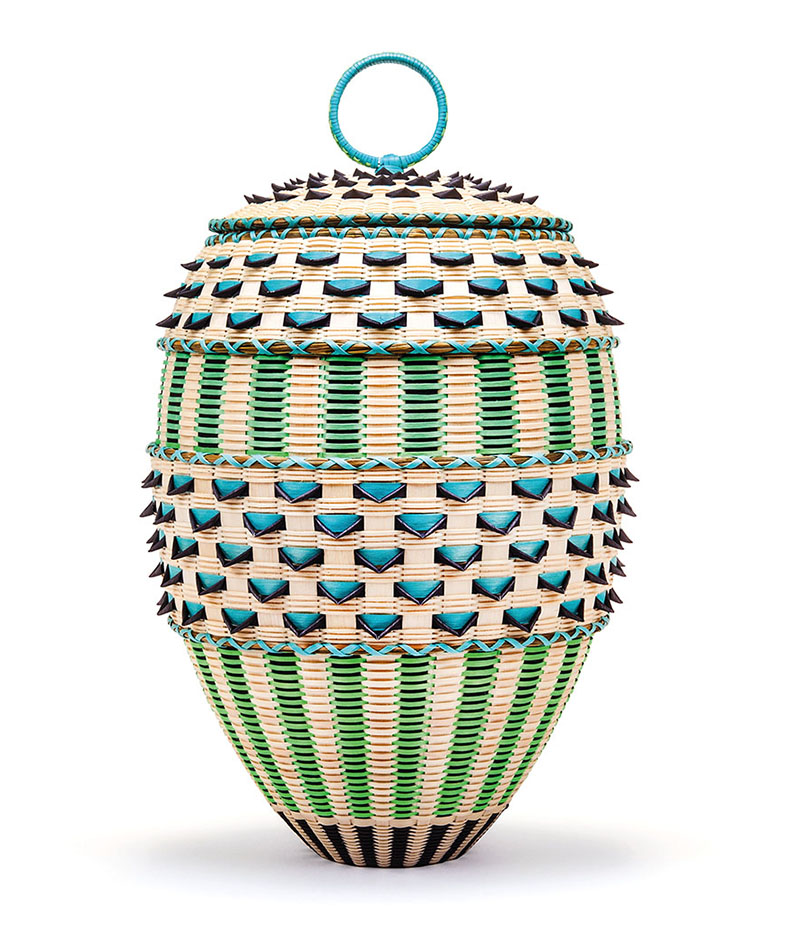
Ten minutes into the video – at least a month in real time – the basket is finished. It is beautiful, with the svelte profile of a Chinese porcelain vase. We see it placed on a plinth in a white-walled gallery. And then (spoiler alert) something unexpected happens. The basket starts to smoke. Then burst into flame. We watch, appalled, as this intricate demonstration of Frey’s passion and artistry blackens, folds in upon itself, and finally collapses into a heap. Only now do we realise that the video’s title has a double meaning. Why? Frey says he has been getting that question a lot. He does not like to provide a clear answer, letting the audience draw its own conclusions about this dramatic act of sacrifice.
One important context is obviously climate change – a vastly bigger, slower burn – which is threatening traditional basket-making, just as it does so many other aspects of life. Summer droughts and disrupted cycles of flooding and freezing are striking literally at the roots of Maine’s ash trees. Worse, they are being attacked by an invasive beetle called the emerald ash borer. Frey, who is now 45, may live to see his own raw material become all but extinct.
Ash also takes place against another human tragedy, still longer in the making: the genocidal assault on Native people and culture. It was only in the middle of the 19th century, after the tribes of the Wabanaki Confederacy had been forcibly removed from their ancestral lands, that people there began making so-called fancy baskets – the antecedents of Frey’s own – using an inventive lexicon of weave structures, points, curls and other ornaments. This was an outpouring of collective creativity, to be sure, but also a response to economic privation. Other means of livelihood had been disrupted; ironically, white settlers were the primary consumers for the refined pieces.
A basket in progress in Jeremy Frey’s studio in 2023. Photo: Jared Lank
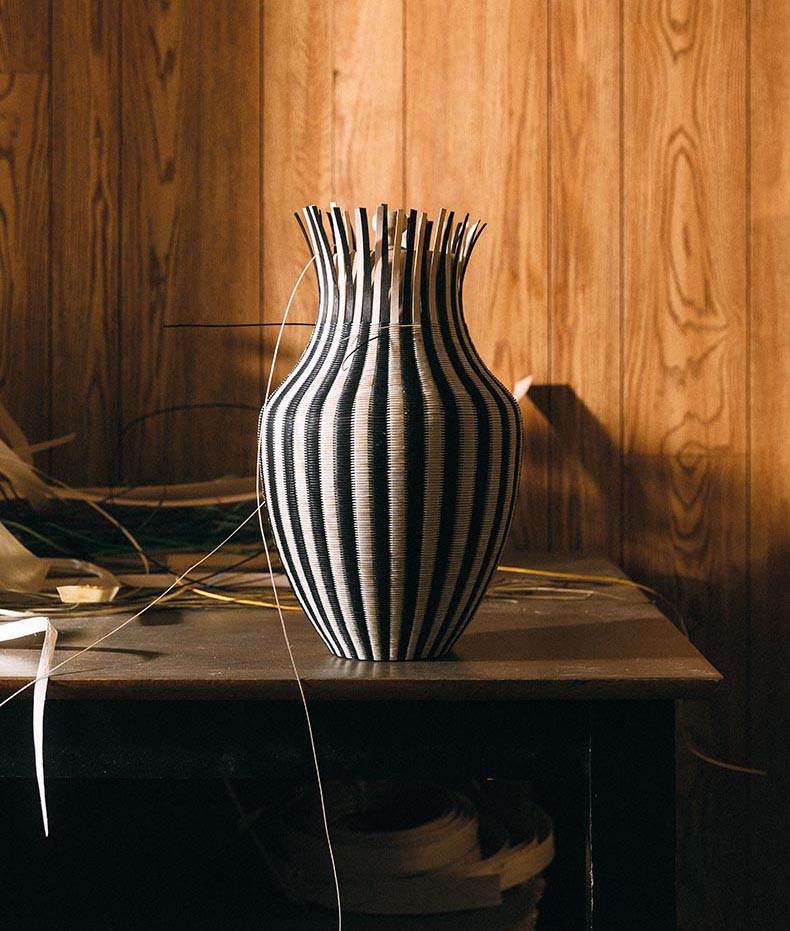
The Passamaquoddy also continued to make plainer, functional baskets, the Tupperware of the times, as Frey puts it. It was an important cottage industry, serving local fisheries and other markets, but it was gruelling, poorly compensated work. Frey, whose baskets now command five-figure prices, is well aware that his ancestors plied the same skills for pennies a day. The annihilation of the basket, in Ash, forces this history to the fore. The appreciation of Native artistry has always gone hand in hand with their oppression, a dynamic that Frey inverts: if we find the destruction of one basket so heartbreaking, how about the destruction of a whole way of life?
Yet Frey’s video, and his work in general, are too multivalent to be read exclusively within a Native context. In 1923, Man Ray called one of his assemblage works Object to be Destroyed. In the century since, many other artists have done just that, sometimes to protest against commodification, sometimes in an act of self-transformation. (In 1970 John Baldessari did both, burning most of his own paintings in an action he called The Cremation Project, then following it up with a text-based work, I Will Not Make Any More Boring Art.) So Ash actually exists within another long tradition, that of the modernist avant-garde.
Observer (2022), Jeremy Frey. Collection of Carole Katz, California. Photo: Eric Stoner; © the artist
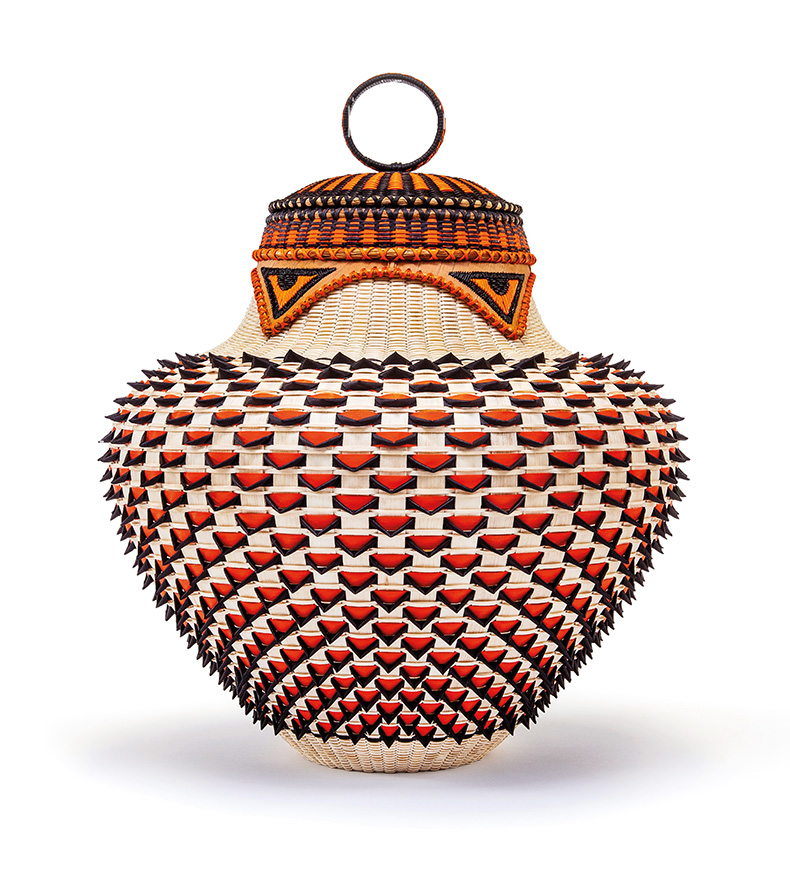
And it’s not just the video. Frey’s retrospective shows him to be an artist of tremendous range and formal command. In addition to the 50 baskets on view (and that one video), there are several wall-based works executed using his usual basket-making techniques. Most of these are cruciform, bound tightly at the middle and bursting free into space, up, down and side to side. In one extraordinary work, a concave abyss let into one of the gallery walls, Frey shows us what Anish Kapoor might be able to accomplish if only he knew how to weave.
But it’s the baskets that establish Frey as a major contemporary artist. They occupy space as only great sculpture can, as if touching down from some other world. When conceiving and making a piece, he says, he does like to imagine a setting for it, complete with fictional owner. This perhaps accounts for the charisma that his works possess. Each has a distinct personality, created by silhouette, structure and colour palette (achieved with nothing more arcane than Rit All-Purpose Dyes, but to marvellous effect).
One work in the Portland show even comes across as a self-portrait. Titled Navigating Tradition, its exterior is executed in neutral ash, with a rough finish highly unusual in his work. The real surprise, though, is on the inside: a vivid, tightly woven checkerboard in red and violet. It’s difficult to reconcile the basket with its own interior, lending the work an almost virtual quality, as if it were a portal to some other dimension.
Navigating Tradition (2023), Jeremy Frey. Photo: courtesy the artist/Karma, New York; © the artist
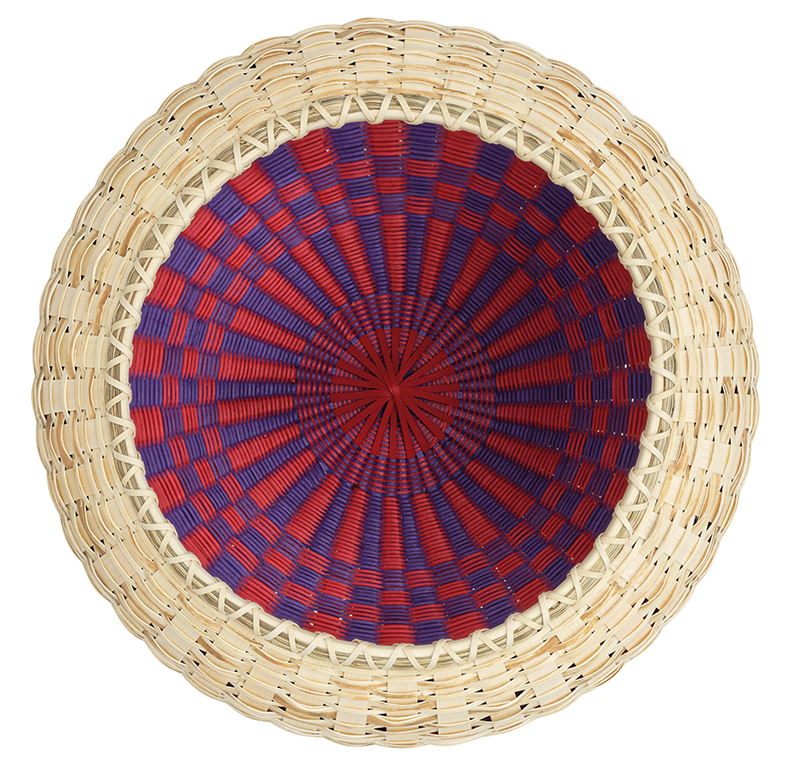
This is a great example of the way that Frey deploys his impressive repertoire to new expressive ends. To make Navigating Tradition, he used an ‘over-weave’ technique, essentially grafting one basket on to another. To call him a contemporary artist is in no way to diminish his stature as a superlative craftsman; the two identities are tightly bound together. This is a point worth underlining, for too often saying that a craftsperson is also a fine artist is taken to mean that they’ve transcended a static past. As Theresa Secord, the founding director of MIBA, notes in her excellent essay for the exhibition catalogue, ‘when I began working with the mostly elderly basket makers in 1993, if the word “artist” was mentioned, they would wonder who I was talking about.’
It’s true that when Frey first began showing his work in settings like the Santa Fe Indian Market, he consciously set out to stand apart from the crowd. That he most certainly did – in his third year there, he won Best of Show, the first time a basket-maker had been so recognised. But he had distinguished himself not by departing from precedent, but by delving into his inherited repertoire with unprecedented intensity.
Rather than working quickly to get to larger scale, or substituting unorthodox materials, as other makers were doing, he homed in, making weaves of astonishing fineness and regularity. This meant slowing down, connecting to what Ramey Mize, who co-curated the Portland Museum show with Jaime DeSimone, aptly calls ‘tree time’. To appreciate this quality fully, it helps to know that the vertical elements in a basket must be contoured on their edges, somewhat like the staves of a barrel or the strakes of a boat. Where the form swells out, each one must be a bit wider; at the base, and where it tightens in again at the neck, it has to narrow. Working only with a knife and by eye, Frey creates these shapes with unerring consistency and accuracy. The result is an immaculate, elegant profile that is echoed in every line.
Watchful Spirit (2022), Jeremy Frey. Denver Art Museum. Photo: courtesy Denver Art Museum; © the artist

The same mastery of detail is seen in every other aspect of his baskets, notably the pictorial emblems that he often stitches into his birch bark lids, using dyed porcupine quill. (According to Frey, this is the most painstaking of all his techniques, because of the embroidery’s tiny scale.) Even if he weren’t already making his respect for Native heritage clear in every fibre, these birds, bears and wolves would leave the matter in no doubt. It’s hardly the standard iconography of contemporary art, and even stands in contrast to his own otherwise abstract sensibility.
Frey wants to have it all: to be a contemporary traditionalist, an artist-artisan, an internationalist exponent of his own tribe. It hasn’t been easy. More than two decades of unremitting effort, willpower and imagination have been necessary to get him this far. Yet he knows that his success, if ‘almost miraculous’, is not his alone to be proud of. It belongs to the Passamaquoddy, to the larger Wabanaki tribal group. It also belongs, more contingently, to the art world as a whole. For it is only thanks to the slow but progressive transformations of the past decades – the purposeful embrace of every kind of person, and the insights that they bring with them – that a career like Frey’s has become possible.
These changes came too late for too many. That burning basket still feels like a necessary part of the story. But at least when someone like Frey tries to lead the way, the path is not totally obstructed, and others can follow. Theresa Secord’s son Caleb Hoffman is now apprenticing in Frey’s studio, the first time Frey has taken on a second pair of hands. The tradition continues. Up, down, over and under – and ever onwards.
‘Jeremy Frey: Woven’ is at the Portland Museum of Art, Maine, until 15 September.
From the July/August 2024 issue of Apollo. Preview and subscribe here.


